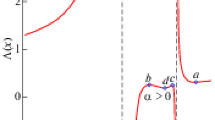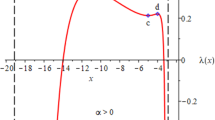Abstract
We study D-dimensional Einstein–Gauss–Bonnet gravitational model including the Gauss–Bonnet term and the cosmological term \(\Lambda \). We find a class of solutions with exponential time dependence of two scale factors, governed by two Hubble-like parameters \(H >0\) and h, corresponding to factor spaces of dimensions \(m >2\) and \(l > 2\), respectively. These solutions contain a fine-tuned \(\Lambda = \Lambda (x, m, l, \alpha )\), which depends upon the ratio \(h/H = x\), dimensions of factor spaces m and l, and the ratio \(\alpha = \alpha _2/\alpha _1\) of two constants (\(\alpha _2\) and \(\alpha _1\)) of the model. The master equation \(\Lambda (x, m, l,\alpha ) = \Lambda \) is equivalent to a polynomial equation of either fourth or third order and may be solved in radicals. The explicit solution for \(m = l\) is presented in “Appendix”. Imposing certain restrictions on x, we prove the stability of the solutions in a class of cosmological solutions with diagonal metrics. We also consider a subclass of solutions with small enough variation of the effective gravitational constant G and show the stability of all solutions from this subclass.








Similar content being viewed by others
Notes
The second relation (1.2) was extended in ref. [28] to \(\Lambda |\alpha | \ge |\lambda _a|\) by adding into consideration the case \(H=h\) [16, 22]. In ref. [28] the cosmological constant \(\Lambda _P\) is related to our one as \(\Lambda _P = 2 \Lambda \) and the internal space dimension l is denoted as D.
References
Zwiebach, B.: Curvature squared terms and string theories. Phys. Lett. B 156, 315 (1985)
Fradkin, E.S., Tseytlin, A.A.: Effective action approach to superstring theory. Phys. Lett. B 160, 69–76 (1985)
Gross, D., Witten, E.: Superstrings modifications of Einstein’s equations. Nucl. Phys. B 277, 1 (1986)
Metsaev, R.R., Tseytlin, A.A.: Two loop beta function for the generalized bosonic sigma model. Phys. Lett. B 191, 354 (1987)
Ishihara, H.: Cosmological solutions of the extended Einstein gravity with the Gauss–Bonnet term. Phys. Lett. B 179, 217 (1986)
Deruelle, N.: On the approach to the cosmological singularity in quadratic theories of gravity: the Kasner regimes. Nucl. Phys. B 327, 253–266 (1989)
Nojiri, S., Odintsov, S.D.: Introduction to modified gravity and gravitational alternative for dark energy. Int. J. Geom. Meth. Mod. Phys. 4, 115–146 (2007). arXiv:hep-th/0601213
Elizalde, E., Makarenko, A.N., Obukhov, V.V., Osetrin, K.E., Filippov, A.E.: Stationary vs. singular points in an accelerating FRW cosmology derived from six-dimensional Einstein–Gauss–Bonnet gravity. Phys. Lett. B 644, 1–6 (2007). arXiv:hep-th/0611213
Bamba, K., Guo, Z.-K., Ohta, N.: Accelerating Cosmologies in the Einstein–Gauss–Bonnet theory with dilaton. Prog. Theor. Phys. 118, 879–892 (2007). arXiv:0707.4334
Kirnos, I.V., Makarenko, A.N.: Accelerating cosmologies in Lovelock gravity with dilaton. Open Astron. J. 3, 37–48 (2010). arXiv:0903.0083
Pavluchenko, S.A.: On the general features of Bianchi-I cosmological models in Lovelock gravity. Phys. Rev. D 80, 107501 (2009). arXiv:0906.0141
Kirnos, I.V., Makarenko, A.N., Pavluchenko, S.A., Toporensky, A.V.: The nature of singularity in multidimensional anisotropic Gauss–Bonnet cosmology with a perfect fluid. Gen. Relativ. Gravit. 42, 2633–2641 (2010). arXiv:0906.0140
Ivashchuk, V.D.: On anisotropic Gauss–Bonnet cosmologies in (n + 1) dimensions, governed by an n-dimensional Finslerian 4-metric. Grav. Cosmol. 16(2), 118–125 (2010). arXiv:0909.5462
Ivashchuk, V.D.: On cosmological-type solutions in multidimensional model with Gauss–Bonnet term. Int. J. Geom. Methods Mod. Phys. 7(5), 797–819 (2010). arXiv:0910.3426
Maeda, K.-I., Ohta, N.: Cosmic acceleration with a negative cosmological constant in higher dimensions. JHEP 1406, 095 (2014). arXiv:1404.0561
Chirkov, D., Pavluchenko, S., Toporensky, A.: Exact exponential solutions in Einstein–Gauss–Bonnet flat anisotropic cosmology. Mod. Phys. Lett. A 29, 1450093 (11 pages) (2014). arXiv:1401.2962
Chirkov, D., Pavluchenko, S.A., Toporensky, A.: Non-constant volume exponential solutions in higher-dimensional Lovelock cosmologies. Gen. Relativ. Gravit. 47: 137 (33 pages) (2015). arXiv:1501.04360
Ivashchuk, V.D., Kobtsev, A.A.: On exponential cosmological type solutions in the model with Gauss-Bonnet term and variation of gravitational constant. Eur. Phys. J. C 75: 177 (12 pages) (2015). Erratum, Eur. Phys. J. C (2016) 76: 584; arXiv:1503.00860
Pavluchenko, S.A.: Stability analysis of exponential solutions in Lovelock cosmologies. Phys. Rev. D 92, 104017 (2015). arXiv:1507.01871
Pavluchenko, S.A.: Cosmological dynamics of spatially flat Einstein–Gauss–Bonnet models in various dimensions: low-dimensional \(\Lambda \)-term case. Phys. Rev. D 94, 084019 (2016). arXiv:1607.07347
Ernazarov, K.K., Ivashchuk, V.D., Kobtsev, A.A.: On exponential solutions in the Einstein–Gauss–Bonnet cosmology, stability and variation of G. Grav. Cosmol. 22(3), 245–250 (2016)
Ivashchuk, V.D.: On stability of exponential cosmological solutions with non-static volume factor in the Einstein–Gauss–Bonnet model. Eur. Phys. J. C 76, 431 (2016). (10 pages); arXiv:1607.01244v2
Ivashchuk, V.D.: On stable exponential solutions in Einstein–Gauss–Bonnet cosmology with zero variation of G. Grav. Cosmol. 22(4), 329–332 (2016). Erratum, Grav. Cosmol. 23 (4), 401 (2017); arXiv:1612.07178
Ernazarov, K.K., Ivashchuk, V.D.: Stable exponential cosmological solutions with zero variation of G in the Einstein–Gauss–Bonnet model with a \(\Lambda \)-term. Eur. Phys. J. C 77, 89 (2017). (6 pages); arXiv:1612.08451
Ernazarov, K.K., Ivashchuk, V.D.: Stable exponential cosmological solutions with zero variation of G and three different Hubble-like parameters in the Einstein–Gauss–Bonnet model with a \(\Lambda \)-term. Eur. Phys. J. C 77, 402 (2017). (7 pages); arXiv:1705.05456
Chirkov, D., Toporensky, A.: On stable exponential cosmological solutions in the EGB model with a cosmological constant in dimensions \(D = 5, 6, 7, 8\). Grav. Cosmol. 23, 359–366 (2017). arXiv:1706.08889
Ivashchuk, V.D., Kobtsev, A.A.: Stable exponential cosmological solutions with \(3\)- and \(l\)-dimensional factor spaces in the Einstein–Gauss–Bonnet model with a \(\Lambda \)-term. Eur. Phys. J. C 78, 100 (2018). (11 pages)
Pabluchenko, S.: Realistic compactification models in Einstein–Gauss–Bonnet gravity. Particles 1(1), 4 (21 pages) (2018). arXiv:1803.01887
Riess, A.G., et al.: Observational evidence from supernovae for an accelerating universe and a cosmological constant. Astron. J. 116, 1009–1038 (1998)
Perlmutter, S.: Measurements of omega and lambda from 42 high-redshift supernovae. Astrophys. J. 517, 565–586 (1999)
Kowalski, M., Rubin, D., et al.: Improved cosmological constraints from new, old and combined supernova datasets. Astrophys. J. 686(2), 749–778 (2008). arXiv:0804.4142
Garraffo, C., Giribet, G.: The lovelock black holes. Mod. Phys. Lett. A 23, 1801–1818 (2008). arXiv:0805.3575v4 [gr-qc]
Ivashchuk, V.D., Kobtsev, A.A.: Exact exponential cosmological solutions with two factor spaces of dimension \(m\) in EGB model with a \(\Lambda \)-term (unpublished)
Ade, P.A.R., et al., [Planck Collaboration]: Planck 2013 results. I. Overview of products and scientific results. Astron. Astrophys. 571, A1 (2014)
Buchel, A., Escobedo, J., Myers, R.C., Paulos, M.F., Sinha, A., Smolkin, M.: Holographic GB gravity in arbitrary dimensions. JHEP 1003, 111 (2010). arXiv:0911.4257 [hep-th]
-Cai, R.G., Quo, Q.: Gauss-Bonnet black holes in dS spaces. Physical Review D 69(10), 104025 (9 pages) (2004). arXiv:hep-th/0311020
Rainer, M., Zhuk, A.: Einstein and Brans–Dicke frames in multidimensional cosmology. Gen. Relativ. Gravit. 32, 79–104 (2000). arXiv:gr-qc/9808073
Ivashchuk, V.D., Melnikov, V.N.: Multidimensional gravity with Einstein internal spaces. Grav. Cosmol. 2(3), 211–220 (1996). arXiv:hep-th/9612054
Bronnikov, K.A., Ivashchuk, V.D., Melnikov, V.N.: Time variation of gravitational constant in multidimensional cosmology. Nuovo Cimento B 102, 209–215 (1998)
Melnikov, V.N.: Models of G time variations in diverse dimensions. Front. Phys. China 4, 75–93 (2009)
Pitjeva, E.V.: Updated IAA RAS planetary ephemerides-EPM2011 and their use in scientific research. Astron. Vestnik 47(5), 419–435 (2013). arXiv:1308.6416
Lovelock, D.: The four-dimensionality of space and the Einstein tensor. J. Math. Phys. 13, 874 (1972)
Acknowledgements
The publication has been prepared with the support of the “RUDN University Program 5-100”. It was also partially supported by the Russian Foundation for Basic Research, Grant Nr. 16-02-00602.
Author information
Authors and Affiliations
Corresponding author
Appendices
Appendix
The analytical solution for \(m=l\)
For any \(m = l > 2\) the master Eq. (3.33) reads
where
It may be readily solved in radicals, by using the substitution \(y = x + \frac{1}{x}\) [33]. For \(A \ne 0\) we obtain
where \(\nu _1 = \pm \,1\), \(\nu _2 = \pm \,1\) and
We get
For \(A = 0\), the solution reads
where
The special solution for \(m=3\) was considered recently in ref. [27].
The proof of the Lemma
Here we give the proof of the Lemma from Sect. 2. The calculations (by using Mathematica) lead us to following relations
where
In order to prove \({\mathcal {R}}_{-}(m,l) <0\) it is sufficient to prove that \(A_{*}(m,l) > 0\) for \(m>2\) and \(l>2\).
Let \(m \ge 4\). Then we group \(A_*(m,l)\) as the sum of the non-negative terms:
where
Thus, we get \(A_{*}(m,l) > 0\) for \(m \ge 4\) and \(l > 2\). For \(m=3\) we have \(A_*(3,l)=l^3+5l^2+8l-12 \ge 84 \) (as \(l\ge 3\)). Thus, \({\mathcal {R}}_{-}(m,l) < 0\) (\(m>2\), \(l>2\)) is proved.
Now we prove \({\mathcal {R}}_{+}(m,l) < 0\) (\(m>2\), \(l>2\))). By using the identities (3.18), (3.25) and definitions of \({\mathcal {R}}_{\pm }(m,l)\) we obtain
By this we complete the proof of the Lemma.
Rights and permissions
About this article
Cite this article
Ivashchuk, V.D., Kobtsev, A.A. Stable exponential cosmological solutions with two factor spaces in the Einstein–Gauss–Bonnet model with a \(\Lambda \)-term. Gen Relativ Gravit 50, 119 (2018). https://doi.org/10.1007/s10714-018-2447-4
Received:
Accepted:
Published:
DOI: https://doi.org/10.1007/s10714-018-2447-4




